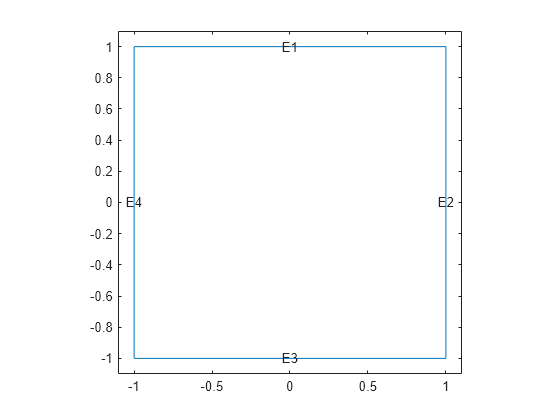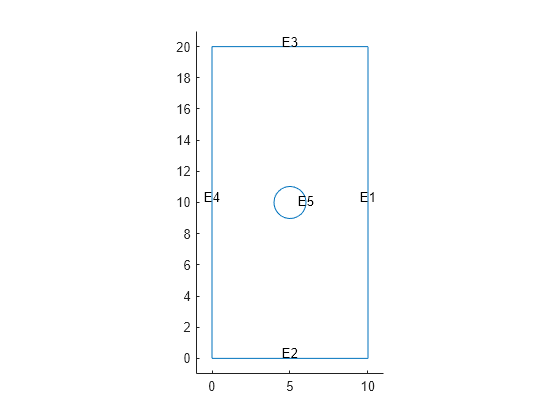edgeBC
Description
An edgeBC object specifies the type of boundary
condition on an edge of a geometry. An femodel object contains
an array of edgeBC objects in its EdgeBC property.
Creation
Description
model.EdgeBC(
creates an EdgeID) = edgeBC(Name=Value)edgeBC object and sets properties using one
or more name-value arguments. This syntax assigns the specified structural, thermal, or
electromagnetic boundary condition to the specified edges of the geometry stored in the
femodel object model. For example,
model.EdgeBC([2 5]) = edgeBC(Constraint="fixed") specifies that edges
2 and 5 are fixed boundaries.
Input Arguments
Edge IDs, specified as a vector of positive integers. Find the edge IDs using
pdegplot with the
EdgeLabels value set to "on".
Data Types: double
Properties
Standard structural boundary constraints, specified as
"fixed".
Data Types: char | string
x-component of enforced displacement, specified as a real number
or function handle. The function must return a row vector. Each element of this vector
corresponds to the x-component value of the enforced displacement at
the boundary coordinates provided by the solver. For a transient or frequency response
analysis, XDisplacement also can be a function of time or frequency,
respectively. For details, see Nonconstant Parameters of Finite Element Model.
For axisymmetric models, this property contains the radial component of the enforced displacement.
Data Types: double | function_handle
y-component of enforced displacement, specified as a real number
or function handle. The function must return a row vector. Each element of this vector
corresponds to the y-component value of the enforced displacement at
the boundary coordinates provided by the solver. For a transient or frequency response
analysis, YDisplacement also can be a function of time or frequency,
respectively. For details, see Nonconstant Parameters of Finite Element Model.
For axisymmetric models, this property contains the axial component of the enforced displacement.
Data Types: double | function_handle
z-component of enforced displacement for a 3-D model, specified
as a real number or function handle. The function must return a row vector. Each element
of this vector corresponds to the z-component value of the enforced
displacement at the boundary coordinates provided by the solver. For a transient or
frequency response analysis, ZDisplacement also can be a function of
time or frequency, respectively. For details, see Nonconstant Parameters of Finite Element Model.
Data Types: double | function_handle
Temperature boundary condition, specified as a real number or function handle. Use a function handle to specify a temperature that depends on space and time. For details, see Nonconstant Parameters of Finite Element Model.
Data Types: double | function_handle
Voltage, specified as a real number or function handle. Use a function handle to specify a voltage that depends on the coordinates. For details, see Nonconstant Parameters of Finite Element Model.
The solver uses a voltage boundary condition for an electrostatic analysis.
Data Types: double | function_handle
Electric field, specified as a column vector of two elements for a 2-D model, vector of three elements for a 3-D model, or function handle. Use a function handle to specify an electric field that depends on the coordinates. For details, see Nonconstant Parameters of Finite Element Model.
The solver uses an electric field boundary condition for a harmonic analysis with an electric field type.
Data Types: double | function_handle
Magnetic field, specified as a column vector of two elements for a 2-D model, column vector of three elements for a 3-D model, or function handle. Use a function handle to specify a magnetic field that depends on the coordinates. For details, see Nonconstant Parameters of Finite Element Model.
The solver uses a magnetic field boundary condition for a harmonic analysis with a magnetic field type.
Data Types: double | function_handle
Magnetic potential, specified as a real number, column vector of three elements for a 3-D model, or function handle. Use a function handle to specify a magnetic potential that depends on the coordinates.
The solver uses a magnetic potential boundary condition for a magnetostatic analysis.
Data Types: double | function_handle
Absorbing region, specified as a farFieldBC
object. Properties of this object specify the thickness of the absorbing region,
exponent and scaling parameter defining the attenuation rate of the waves entering the
absorbing region.
The solver uses an absorbing boundary condition for a harmonic analysis.
Examples
Specify a temperature boundary condition for an femodel object representing a steady-state thermal problem.
Create an femodel object for solving a steady-state thermal problem, and assign the unit square geometry to the model.
model = femodel(AnalysisType="thermalSteady", ... Geometry=@squareg);
Plot the geometry with the edge labels.
pdegplot(model.Geometry,EdgeLabels="on");
xlim([-1.1 1.1])
ylim([-1.1 1.1])
Apply a temperature boundary condition on two edges of the square.
model.EdgeBC([1 3]) = edgeBC(Temperature=100); model.EdgeBC
ans = 1×4 edgeBC array Properties for analysis type: thermalSteady Index Temperature 1 100 2 [] 3 100 4 [] Show all properties
Specify an absorbing boundary condition for an femodel object representing a harmonic electromagnetic problem.
Create an femodel object for solving a harmonic electromagnetic problem with an electric field type. Assign a geometry representing a 2-D plate with a hole to the model.
model = femodel(AnalysisType="electricHarmonic", ... Geometry="PlateHolePlanar.stl");
Plot the geometry with the edge labels.
pdegplot(model.Geometry,EdgeLabels="on");
xlim([-1 11])
ylim([-1 21])
Specify an electric field on the circular edge.
model.EdgeBC(5) = edgeBC(ElectricField=[10 0]); model.EdgeBC
ans = 1×5 edgeBC array Properties for analysis type: electricHarmonic Index ElectricField FarField 1 [] [] 2 [] [] 3 [] [] 4 [] [] 5 [10 0] [] Show all properties
Specify absorbing regions with a thickness of 2 on the edges of the rectangle. Use the default attenuation rate for the absorbing regions.
ffbc = farFieldBC(Thickness=2); model.EdgeBC(1:4) = edgeBC(FarField=ffbc); model.EdgeBC
ans = 1×5 edgeBC array Properties for analysis type: electricHarmonic Index ElectricField FarField 1 [] [1×1 farFieldBC] 2 [] [1×1 farFieldBC] 3 [] [1×1 farFieldBC] 4 [] [1×1 farFieldBC] 5 [10 0] [] Show all properties
Check the parameters of the absorbing region for edge 1.
model.EdgeBC(1).FarField
ans =
farFieldBC with properties:
Thickness: 2
Exponent: 4
Scaling: 5
Now specify the attenuation rate for the absorbing regions.
ffbc = farFieldBC(Thickness=2,Exponent=3,Scaling=100); model.EdgeBC(1:4) = edgeBC(FarField=ffbc); model.EdgeBC(1).FarField
ans =
farFieldBC with properties:
Thickness: 2
Exponent: 3
Scaling: 100
Version History
Introduced in R2023a
See Also
Objects
femodel|fegeometry|farFieldBC|faceBC|vertexBC|cellLoad|faceLoad|edgeLoad|vertexLoad
MATLAB Command
You clicked a link that corresponds to this MATLAB command:
Run the command by entering it in the MATLAB Command Window. Web browsers do not support MATLAB commands.
Select a Web Site
Choose a web site to get translated content where available and see local events and offers. Based on your location, we recommend that you select: .
You can also select a web site from the following list
How to Get Best Site Performance
Select the China site (in Chinese or English) for best site performance. Other MathWorks country sites are not optimized for visits from your location.
Americas
- América Latina (Español)
- Canada (English)
- United States (English)
Europe
- Belgium (English)
- Denmark (English)
- Deutschland (Deutsch)
- España (Español)
- Finland (English)
- France (Français)
- Ireland (English)
- Italia (Italiano)
- Luxembourg (English)
- Netherlands (English)
- Norway (English)
- Österreich (Deutsch)
- Portugal (English)
- Sweden (English)
- Switzerland
- United Kingdom (English)